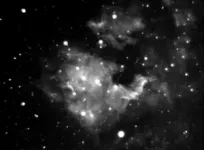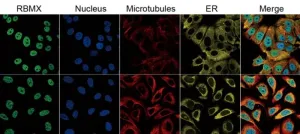(Press-News.org) Metalenses have been used to image microscopic features of tissue and resolve details smaller than a wavelength of light. Now they are going bigger.
Researchers at the Harvard John A. Paulson School of Engineering and Applied Sciences (SEAS) have developed a 10-centimeter-diameter glass metalens that can image the sun, the moon and distant nebulae with high resolution. It is the first all-glass, large-scale metalens in the visible wavelength that can be mass produced using conventional CMOS fabrication technology.
The research is published in ACS Nano.
“The ability to accurately control the size of tens of billions of nanopillars over an unprecedentedly large flat lens using state-of-the-art semiconductor foundry processes is a nanofabrication feat that opens exciting new opportunities for space science and technology,” said Federico Capasso, the Robert L. Wallace Professor of Applied Physics and Vinton Hayes Senior Research Fellow in Electrical Engineering at SEAS and senior author of the paper.
Most flat metalenses, which use millions of pillar-like nanostructures to focus light, are about the size of a piece of glitter. In 2019, Capasso and his team developed a centimeter-scale metalens using a technique called deep-ultraviolet (DUV) projection lithography, which projects and forms a nanostructure pattern that can be directly etched into the glass wafer, eliminating the time-consuming writing and deposition processes that were required for previous metalenses.
DUV projection lithography is commonly used to pattern fine lines and shapes in silicon chips for smartphones and computers. Joon-Suh Park, a former graduate student at SEAS and current postdoctoral fellow in Capasso's team, demonstrated that the technique could not only be used to mass produce metalenses but also increase their size for applications in virtual and augmented reality.
But making the metalens even larger for applications in astronomy and free-space optical communications posed an engineering problem.
“There is a major limitation with the lithography tool because these tools are used to make computer chips, so chip size is restricted to no more than 20 to 30 millimeters,” said Park, co-first author of the paper. “In order to make a 100-millimeter diameter lens, we needed to find a way around this limitation.”
Park and the team developed a technique to stitch together several patterns of nanopillars using the DUV projection lithography tool. By dividing the lens into 25 sections but using only the 7 sections of a quadrant considering the rotational symmetry, the researchers showed that DUV projection lithography could pattern 18.7 billion designed nanostructures onto a 10-centimeter circular area in a matter of minutes. The team also developed a vertical glass etching technique that allows the creation of high-aspect ratio, smooth-sidewall nanopillars etched into glass.
“Using the same DUV projection lithography, one could produce large-diameter, aberration-correcting meta-optics or even larger lenses on larger glass diameter wafers as the corresponding CMOS foundry tools become increasingly available in the industry,” said Soon Wei Daniel Lim, a postdoctoral fellow at SEAS and co-first author of the paper.
Lim played a lead role in the full simulation and characterization of all the possible fabrication errors that could arise during mass-manufacturing processes and how they could impact the optical performance of metalenses.
After addressing possible manufacturing challenges, the researchers demonstrated the power of the metalens in imaging celestial objects.
Mounting the metalens on a tripod with a color filter and camera sensor, Park and the team took to the roof of Harvard’s Science Center. There, they imaged the Sun, the moon and the North America nebula, a dim nebula in the constellation Cygnus about 2,590 light years away.
“We were able to get very detailed images of the Sun, the moon and the nebula that are comparable to images taken by conventional lenses” said Arman Amirzhan, a graduate student in the Capasso Lab and co-author of the paper.
Using only the metalens, the researchers were able to image the same cluster of sunspots as a NASA image taken that same day.
The team also demonstrated that the lens could survive exposure to extreme heat, extreme cold and the intense vibrations that would occur during a space launch without any damage or loss in optical performance.
Because of its size and monolithic glass composition, the lens could also be used for long-range telecommunications and directed energy transport applications.
The research is co-authored by Hyukmo Kang, Karlene Karrfalt, Daewook Kim, Joel Leger, Augustine Urbas, Marcus Ossiander and Zhaoyi Li. It was supported by the Defense Advanced Research Projects Agency (DARPA) Grant No. HR00111810001 and the Air Force Office of Scientific Research under Award No. FA9550-22-1-0312.
END
The metalens meets the stars
Large, all-glass metalens images sun, moon and nebulae
2024-01-17
ELSE PRESS RELEASES FROM THIS DATE:
New U of A-based study to examine very rare adverse events linked to COVID-19 vaccines
2024-01-17
EDMONTON — A University of Alberta professor is co-leading a new international vaccine safety network to examine why some people who received a COVID-19 vaccine experienced very rare adverse events associated with the vaccine.
The International Network of Special Immunization Services (INSIS), based at the U of A, is a consortium of academic medical centres around the world coming together to study very rare adverse events after vaccination. An adverse reaction is considered very rare when it affects less than .001 per cent of the population.
“The bar for safety with vaccines is very high because we’re giving them ...
$24 million grant to extend Study of Healthy Aging in African Americans (STAR)
2024-01-17
Researchers at UC Davis Health and Kaiser Permanente Division of Research have received a $24 million grant from the National Institute on Aging, part of the National Institutes of Health (NIH), to continue the Study of Healthy Aging in African Americans (STAR) for an additional five years.
STAR, which launched in 2017, follows a group of approximately 750 older adults to understand how behaviors and lifestyle may increase the risk of Alzheimer’s disease and related dementias for Black and African Americans. The study ...
Metastatic breast cancer treatments have aided decline in deaths, Stanford Medicine-led study finds
2024-01-17
Deaths from breast cancer dropped 58% between 1975 and 2019 due to a combination of screening mammography and improvements in treatment, according to a new multicenter study led by Stanford Medicine clinicians and biomedical data scientists.
Nearly one-third of the decrease (29%) is due to advances in treating metastatic breast cancer —a form that has spread to other areas of in the body and is known as stage 4 breast cancer or recurrent cancer. Although these advanced cancers are not considered curable, women with metastatic disease are living longer than ever.
The analysis helps cancer researchers assess where to focus future efforts and resources.
“We’ve ...
Aberrant RBMX expression relevant for cancer prognosis and immunotherapy response
2024-01-17
“In the future, targeting of RBMX may be a novel method in cancer therapy.”
BUFFALO, NY- January 17, 2024 – A new research paper was published in Aging (listed by MEDLINE/PubMed as "Aging (Albany NY)" and "Aging-US" by Web of Science) Volume 16, Issue 1, entitled, “Aberrant RBMX expression is relevant for cancer prognosis and immunotherapy response.”
Cancer accounts for the highest rates of morbidity and mortality worldwide. RNA binding motif protein X-linked (RBMX) is a nuclear ...
Higher measurement accuracy opens new window to the quantum world
2024-01-17
A team at HZB has developed a new measurement method that, for the first time, accurately detects tiny temperature differences in the range of 100 microkelvin in the thermal Hall effect. Previously, these temperature differences could not be measured quantitatively due to thermal noise. Using the well-known terbium titanate as an example, the team demonstrated that the method delivers highly reliable results. The thermal Hall effect provides information about coherent multi-particle states in quantum materials, based on their interaction with lattice vibrations (phonons).
The laws of quantum physics apply to all materials. However, in so-called ...
National collaborative for health equity roundtable: a call for unity and the power of racial healing
2024-01-17
A new Roundtable discussion in the peer-reviewed journal Health Equity explores the results of a poll conducted by the National Collaborative for Health Equity (NCHE), called the “Heart of America Annual Survey.” The survey found that more than 80% of respondents want a national leader that unifies rather than divides us, suggesting that there is a readiness in the country to put polarization and division behind us so that we can solve our collective and common challenges and problems. Click here to read the Roundtable now.
Moderating ...
New project to improve modeling of climate change
2024-01-17
Jingrui He, professor of information sciences at the University of Illinois Urbana-Champaign, has been awarded a two-year, $600,000 grant from the IBM-Illinois Discovery Accelerator Institute to improve modeling climate change and its impact across multiple application domains. He and a team of researchers from the University of Illinois and IBM will build Climate Runtime, a computational framework integrating cutting-edge capabilities from climate foundation models and multimodal fusion. This framework will allow for accurate prediction and quantification of weather and climate events and their impact in areas such as finance ...
Climate change isn’t producing expected increase in atmospheric moisture over dry regions
2024-01-17
Contacts:
David Hosansky, UCAR and NSF NCAR Manager of Media Relations
hosansky@ucar.edu
720-470-2073
Audrey Merket, UCAR and NSF NCAR Science Writer and Public Information Officer
amerket@ucar.edu
303-497-8293
The laws of thermodynamics dictate that a warmer atmosphere can hold more water vapor, but new research has found that atmospheric moisture has not increased as expected over arid and semi-arid regions of the world as the climate has warmed.
The findings are particularly puzzling because climate models have been predicting ...
New research highlights unprecedented targeted approach to treating triple-negative breast cancer
2024-01-17
Cleveland Clinic researchers have successfully developed a therapeutic peptide that blocks aggressive cancer cells from multiplying rapidly. The results highlight a potential new strategy for developing targeted treatments for triple-negative breast cancer, which currently has no approved options.
Targeted drugs attack cancer cell functions directly, offering a more precise approach to complement broader treatments like chemotherapy. A research team led by Ofer Reizes, PhD, and Justin Lathia, PhD, designed a peptide therapeutic that disrupts the molecular processes behind aggressive cancer growth when delivered into cells.
The ...
ASBMB names Mona V. Miller as next executive officer
2024-01-17
The American Society for Biochemistry and Molecular Biology today named Mona V. Miller its next chief executive officer, effective April 1.
Miller is an experienced association leader with significant experience in strategic planning, advocacy and fundraising. Most recently, she was CEO of the American Society of Human Genetics. Before that she held multiple high-level positions at the Society for Neuroscience.
Miller said she was drawn to the ASBMB because “scientifically, biochemistry and molecular biology is at the forefront of knowledge that is transforming health and society.”
She said she looks forward to “focusing on the pivotal ...
LAST 30 PRESS RELEASES:
Cannabis derivatives could provide new ovarian cancer treatments
Raising strong yeast as a petroleum substitute
Clues to the origin of hot Jupiters hidden in their orbits
Canada’s reduced pledge to Global Fund will impact domestic health
1 in 4 children with major traumatic injuries not cared for in pediatric trauma centres
Duke and Duke-NUS’ joint cross-population research to uncover "East-West" differences in disease and care
Scientists to ‘spy’ on cancer- immune cell interactions using quantum technology breakthrough
Tech savvy users have most digital concerns
Making lighter work of calculating fluid and heat flow
Normalizing blood sugar can halve heart attack risk
Lowering blood sugar cuts heart attack risk in people with prediabetes
Study links genetic variants to risk of blinding eye disease in premature infants
Non-opioid ‘pain sponge’ therapy halts cartilage degeneration and relieves chronic pain
AI can pick up cultural values by mimicking how kids learn
China’s ecological redlines offer fast track to 30 x 30 global conservation goal
Invisible indoor threats: emerging household contaminants and their growing risks to human health
Adding antibody treatment to chemo boosts outcomes for children with rare cancer
Germline pathogenic variants among women without a history of breast cancer
Tanning beds triple melanoma risk, potentially causing broad DNA damage
Unique bond identified as key to viral infection speed
Indoor tanning makes youthful skin much older on a genetic level
Mouse model sheds new light on the causes and potential solutions to human GI problems linked to muscular dystrophy
The Journal of Nuclear Medicine ahead-of-print tip sheet: December 12, 2025
Smarter tools for peering into the microscopic world
Applications open for funding to conduct research in the Kinsey Institute archives
Global measure underestimates the severity of food insecurity
Child survivors of critical illness are missing out on timely follow up care
Risk-based vs annual breast cancer screening / the WISDOM randomized clinical trial
University of Toronto launches Electric Vehicle Innovation Ontario to accelerate advanced EV technologies and build Canada’s innovation advantage
Early relapse predicts poor outcomes in aggressive blood cancer
[Press-News.org] The metalens meets the starsLarge, all-glass metalens images sun, moon and nebulae







